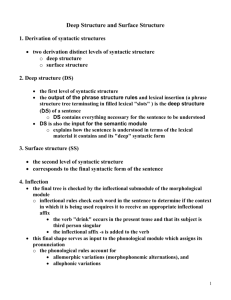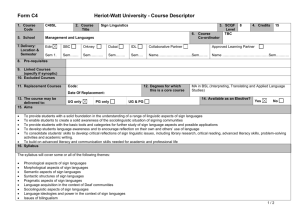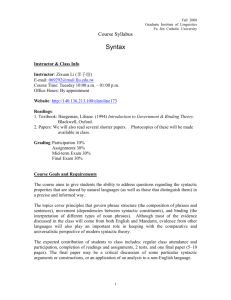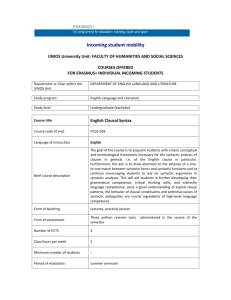Lexical semantics is messy – making sense of it
advertisement
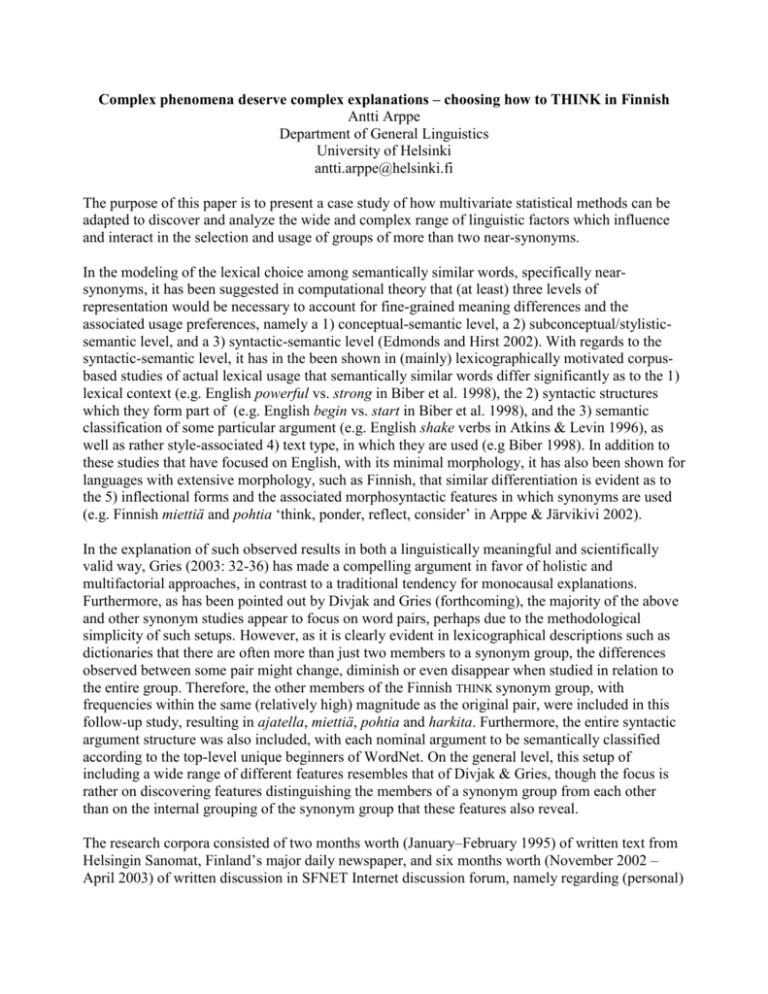
Complex phenomena deserve complex explanations – choosing how to THINK in Finnish Antti Arppe Department of General Linguistics University of Helsinki antti.arppe@helsinki.fi The purpose of this paper is to present a case study of how multivariate statistical methods can be adapted to discover and analyze the wide and complex range of linguistic factors which influence and interact in the selection and usage of groups of more than two near-synonyms. In the modeling of the lexical choice among semantically similar words, specifically nearsynonyms, it has been suggested in computational theory that (at least) three levels of representation would be necessary to account for fine-grained meaning differences and the associated usage preferences, namely a 1) conceptual-semantic level, a 2) subconceptual/stylisticsemantic level, and a 3) syntactic-semantic level (Edmonds and Hirst 2002). With regards to the syntactic-semantic level, it has in the been shown in (mainly) lexicographically motivated corpusbased studies of actual lexical usage that semantically similar words differ significantly as to the 1) lexical context (e.g. English powerful vs. strong in Biber et al. 1998), the 2) syntactic structures which they form part of (e.g. English begin vs. start in Biber et al. 1998), and the 3) semantic classification of some particular argument (e.g. English shake verbs in Atkins & Levin 1996), as well as rather style-associated 4) text type, in which they are used (e.g Biber 1998). In addition to these studies that have focused on English, with its minimal morphology, it has also been shown for languages with extensive morphology, such as Finnish, that similar differentiation is evident as to the 5) inflectional forms and the associated morphosyntactic features in which synonyms are used (e.g. Finnish miettiä and pohtia ‘think, ponder, reflect, consider’ in Arppe & Järvikivi 2002). In the explanation of such observed results in both a linguistically meaningful and scientifically valid way, Gries (2003: 32-36) has made a compelling argument in favor of holistic and multifactorial approaches, in contrast to a traditional tendency for monocausal explanations. Furthermore, as has been pointed out by Divjak and Gries (forthcoming), the majority of the above and other synonym studies appear to focus on word pairs, perhaps due to the methodological simplicity of such setups. However, as it is clearly evident in lexicographical descriptions such as dictionaries that there are often more than just two members to a synonym group, the differences observed between some pair might change, diminish or even disappear when studied in relation to the entire group. Therefore, the other members of the Finnish THINK synonym group, with frequencies within the same (relatively high) magnitude as the original pair, were included in this follow-up study, resulting in ajatella, miettiä, pohtia and harkita. Furthermore, the entire syntactic argument structure was also included, with each nominal argument to be semantically classified according to the top-level unique beginners of WordNet. On the general level, this setup of including a wide range of different features resembles that of Divjak & Gries, though the focus is rather on discovering features distinguishing the members of a synonym group from each other than on the internal grouping of the synonym group that these features also reveal. The research corpora consisted of two months worth (January–February 1995) of written text from Helsingin Sanomat, Finland’s major daily newspaper, and six months worth (November 2002 – April 2003) of written discussion in SFNET Internet discussion forum, namely regarding (personal) relationships (sfnet.keskustelu.ihmissuhteet) and politics (sfnet.keskustelu.politiikka). The newspaper corpus consisted altogether of 3,304,512 words of body text, excluding headers and captions, including 1,750 representatives of the studied THINK verbs, whereas the Internet corpus comprised altogether 409,216 words of body text, excluding quotes of previous postings, adding up to 1,654 representatives of the studied THINK verbs. The corpora were first automatically syntactically and morphologically analyzed using an implementation of the Functional-Dependency Grammar parser (Tapanainen & Järvinen 1997) for Finnish, after which all the instances of the studied verbs together with their syntactic arguments were manually checked, corrected and supplemented with the semantic classifications. Using the χ2 statistic, a subset of contextual features exhibiting statistically significant differences in their distributions among the studied verbs was identified, after which several features were further excluded due to their high (positive or negative) correlation with some other feature, so as to reduce collinearity in the subsequent modeling. Then, a multi-level classification model was constructed by applying the double round-robin (aka pairwise) technique (Fürnkranz 2002) on the 4x3 binary logistic regression classifiers, e.g. ajatella vs. miettiä, miettiä vs. ajatella, ajatella vs. pohtia, and so on, trained in the R statistical computing environment with the selected 19 morphosyntactic, 30 syntactic argument, and two text type features, and the research corpus. When repeatedly (20 times) training the model with a random hold-out sample of 2/3 of the entire data and then evaluating the model against the remaining 1/3 of the data, this model could correctly account for on the average 58.6% (s.d. 1.3%) of the lexical choices in the research corpora. This is less than one would hope for, and probably reflects, in addition to a substantial number of cases of true substitutability, as is befitting of synonyms, the complexity of the linguistic phenomenon being modeled and possibly the short-comings of the round-robin technique. However, preliminary trials with other techniques for turning polytomous classification problems into sets of dichotomous classifiers, e.g. one-vs-rest or ensembles of nested dichotomies, i.e. (ENDs), as summarized in Frank & Kramer (2004), do not appear to achieve a higher level of accuracy, either. Table 1. Aggregate of the agent/subject-related statistically significant coefficients in the 4x3 pairwise binary logistic regression classifiers of the four studied THINK verbs (Notation: +: positive coefficient; –: negative coefficient; 0_: morphosyntactic feature of the node or the associated verb chain, the latter designated by ANL; SX_: syntactic argument; SEM_: semantic classification of nominal argument, LX_: specific lexeme as syntactic argument) Lexemes/Contextual features 0_ANL_SINGURAL-1|2 0_ANL_SINGULAR-3 0_ANL_PLURAL-1|2 SX_AGENT+SEM_INDIVIDUAL SX_AGENT+SEM_GROUP ajatella 0 +0 --- miettiä + 0 0 +- pohtia + + + +++ harkita 0 0 0 +- An aggregate of the statistically significant coefficient features in the 12 pairwise classifier models is presented Appendix 1. As can be seen, a wide range of both morphosyntactic and syntactic argument features, as well as the two text types, are associated with the usage and selection of the studied lexemes in a complex, interconnected but linguistically meaningful manner. A particularly interesting set of distinguishing features, shown in Table 1, are those pertaining to the countability and the person/number of agents, as they represent an interaction of both morphosyntactic and syntactic argument features due to the obligatory congruence between the person and number of the predicate verb with its grammatical subject in Finnish. With respect to the countability of the agent, pohtia is associated somewhat positively (+) and harkita negatively (–) with INDIVIDUALS, with ajatella and miettiä as neutral (0), whereas pohtia is clearly positively (+++) and ajatella clearly negatively (---) associated with collective GROUPS, with miettiä and harkita as labile (+/–) in this case. Regarding the person and number of INDIVIDUAL agents, miettiä is associated slightly positively (+)and pohtia slightly negatively (–) with 1ST AND 2ND PERSON SINGULAR forms, whereas pohtia is associated somewhat positively (+) and ajatella somewhat negatively (–) with 1ST AND 2ND PERSON PLURAL forms. On the other hand, pohtia is associated positively (+) and miettiä negatively (–) with 3RD PERSON SINGULAR forms, possible with both INDIVIDUAL and GROUP agents. These results clearly distinguish pohtia ‘ponder, consider’ from the rest as the synonym of choice when collective or plural GROUP agents are involved in thinking in Finnish, whereas similar differentiation is not as clearly evident for INDIVIDUAL agents, all of which is information lacking from current authoritative dictionaries of Finnish. When compared to an earlier pairwise study (Arppe & Järvikivi), these results essentially uphold the agent-related corpus-based distinctions noted then, but also integrate them into the more complex syntactic-semantic network constituted by the four-member THINK synonym group. In addition, similar fine-grained distinctions can also be observed with other syntactic arguments, first and foremost with the patient. In conclusion, these results demonstrate the variety and complexity of different contextual feature categories necessary to explain the use of the studied synonym group. Furthermore, they present an adaptation of a multivariate method, applicable to multi-class problems which synonym groups often are, for how such complex associations can be extracted out of corpora in order to enrich lexicographical knowledge. References Arppe, A. and Järvikivi, J. 2002. Verbal Synonymy in Practice: Combining Corpus-Based and Psycholinguistic Evidence. Quantitative Investigations in Linguistics (QITL-02) workshop, Osnabrück, Germany, 3-5.10.2002. URL: http://www.cogsci.uni-osnabrueck.de/~qitl/. Atkins, B. T. S. and Levin, B. 1995. Building on a Corpus: A linguistic and lexicographical look at some near-synonyms. International Journal of Lexicography, 8:2, pp. 85–114. Biber, D., Conrad, S. and Reppen, R. 1998. Corpus Linguistics: Investigating Language Structure and Use. CUP, Cambridge, England. Church, K., Gale, W., Hanks, P., and Hindle, D. 1991. Using Statistics in Lexical Analysis. In Zernik, U., editor. Lexical Acquisition: Exploiting On-Line Resources to Build a Lexicon. Lawrence Erlbaum Associates, Hillsdale, New Jersey. Divjak, D. and Gries, S. Th. (forthcoming). Ways of trying in Russian: Clustering and comparing behavioral profiles. Corpus Linguistics and Linguistic Theory. Mouton de Gruyter, Berlin Edmonds, P. and Hirst, G. 2002. Near-Synonymy and Lexical Choice. Computational Linguistics 28(2), pp. 105-145. Fürnkranz, J. 2002. Round Robin Classification. Journal of Machine Learning Research 2/2002, pp 721-747. Gries, S. Th. 2003. Multifactorial analysis in corpus linguistics: a study of particle placement. Continuun, London, England. Frank, E. and Cramer, S. 2004. Ensembles of Nested Dichotomies for Multi-class Problems. Proceedings of the 21st International Conference on Machine Learning, Banff, Canada. Tapanainen, P. and Järvinen, T. 1997. A non-projective dependency parser. Proceedings of the 5th Conference on Applied Natural Language Processing (ANLP'97), p. 64–71. Association for Computational Linguistics, Washington, D.C. Appendix 1. Aggregate of the statistically significant coefficients in the pairwise binary logistic regression classifiers of the four studied THINK verbs (Notation: +: positive coefficient; –: negative coefficient; 0_: morphosyntactic feature of the node or the associated verb chain, the latter designated by ANL; SX_: syntactic argument; SEM_: semantic classification of nominal argument; LX_: specific lexeme as syntactic argument) Lexemes/Contextual features Morphosyntactic structure 0_ANL_AFFIRMATIVE 0_ANL_INDICATIVE 0_ANL_CONDITIONAL 0_ANL_IMPERATIVE 0_ANL_SINGURAL-1|2 0_ANL_SINGULAR-3 0_ANL_PLURAL-1|2 0_ANL_PASSIVE 0_INFINITIVE-1 0_INFINITIVE-2 0_INFINITIVE-3 0_INFINITIVE-4 0_PARTICIPLE-1 0_PARTICIPLE-2 0_INESSIVE 0_PARTITIVE Syntactic argument structure SX_AGENT+SEM_INDIVIDUAL SX_AGENT+SEM_GROUP SX_PATIENT SX_PATIENT+SEM_INDIVIDUAL SX_PATIENT+SEM_NOTION SX_PATIENT+SEM_ACTIVITY SX_PATIENT+SEM_COMMUNICATION SX_PATIENT+LX_että_CONJ ’that’ SX_PATIENT+LX_mikä_PRON ’what’ SX_PATIENT+LX_miten_ADV ’how’ SX_SOURCE SX_GOAL SX_MANNER SX_MANNER+LX_tarkka_ADJ ’careful’ SX_QUANTITY SX_LOCATION SX_LOCATION+SEM_EVENT SX_TIME SX_DURATION SX_FREQUENCY SX_AUXILIARY SX_AUXILIARY+LX_joutua_V ’must’ SX_AUXILIARY+LX_voida_V ’can’ SX_COMPLEMENT SX_CONDITION SX_META Genre SRC_ihmissuhteet SRC_hs95 ajatella miettiä pohtia harkita + + + 0 +-+ -0 --- + + + ++ + 0 0 ++ + +++ ++ + ++ + 0 ----+ + + --++ +++ 0 0 0 + 0 0 0 0 + + -0 + + 0 ---++ -----+++ 0 -+++ +++ ----- 0 ++ + ++ ++ + + + +++ + ++ ++ + + + +- +0 0 ++++ 0 0 + ++ + -++ -+ + + +++++-0 + -+ + 0 ++ ++ 0 + ++ + + 0 ++ -- +0 +0 0 0 +++- --- +++- + ++ 0 +-

